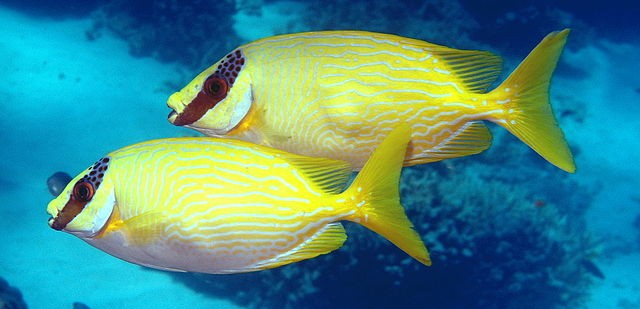Bagoóng is a traditional condiment for Filipino cuisine that is made of fermented fish or shrimp. Bagoóng isdâ, the fishy version, is fermented in brine for several months before it is finally prepared and packaged. This delicacy, which is typically used to enhance the flavor other foods, can be made in different ways with different types of fish. Especially popular is padas, a bagoóng isdâ that is prepared from the juvenile rabbitfish (Siganus spp.). A status symbol, it is customarily served during religious holidays. Vendors sell the specialty item in tightly packed jars in all kinds of shops and markets. Sometimes, the small fish are intricately and artfully arranged within the jar.
For aquarists and aquaculturists, this would be just be an amusing factoid about one commonly kept family of fishes, were it not that intense demand for bagoóng padas products has led to a substantial fishery. Filipino farmers focus on several local rabbitfish species (collectively referred to as malaga or samaral), including Siganus canaliculatus, S. concatenates, S. corallinus and S. spinus. These fishes can easily sell for three times the price of common selections, so competition among producers is fierce. Today, in the Philippines, rabbitfish are a commercially-important fishery, contributing 560 million tons (with juveniles accounting for 60 million tons) to the total annual fishery production. That’s a lot of fish paste.
The culture of siganids as a food fish is well documented. While they are often grown out in cages from stock harvested as juveniles, the induced spawning and larval rearing of rabbitfish in closed systems has been accomplished and reported in detail since the early 1970’s. Some have come to criticize padas farmers on the basis of sustainability, claiming that some of the feeds they use consumes more edible product than it generates. But it is hard to argue that the industry has not been successful. Clearly these farmers have learned a few tricks, and it may be worthwhile for managers of marine ornamental fish hatcheries to take notice. Of course, it would be great to see captive bred rabbitfishes in the trade. But it is possible that some of techniques used by Asian farmers to raise siganids could be a stepping stone to the culture of a sizeable host of pelagic spawning species, including the related acanthurids (tangs and surgeonfishes). Of all siganids, S. argenteus, captive bred for decades and the only member known to be a pelagic spawner, is believed to be most closely related to its surgeonfish cousins. Any help this work could provide to those attempting to raise species such as the highly targeted yellow tang could alone prove to be invaluable.
To review a very old account of the hormonally induced spawning and larval rearing of a rabbitfish species, please visit: http://www.spc.int/DigitalLibrary/Doc/FAME/Meetings/RTMF/7/WP3.pdf











0 Comments